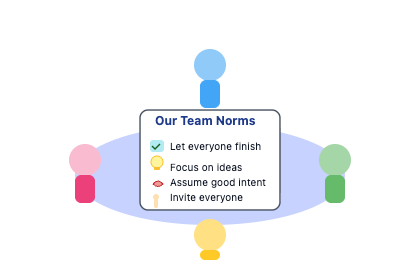Welcome to Navigate Group Conflict! If you’ve ever felt nervous or unsure about what to do when a group disagrees, you’re not alone. Many people worry about saying the wrong thing or making things worse. The good news is, with a few simple skills, you can help your group have better conversations—even when people don’t agree.
In this lesson, you’ll learn:
- How to make it safe for everyone to share their ideas
- Easy ways to show curiosity and keep the conversation open
- How to set simple team rules so everyone feels respected
These basics will help you feel more confident and ready to help your team work through disagreements in a positive way.
When people work together, it’s normal to have different opinions. The important thing isn’t to avoid disagreement, but to make sure everyone feels comfortable sharing their thoughts.
When someone shares an idea—especially if it’s different from your own—try to show genuine interest instead of judging or dismissing it right away. Showing curiosity helps people feel respected and encourages them to share more. For example, instead of saying, “That won’t work,” you might say, “That’s interesting! Can you tell me more about how that would work?” You can also ask follow-up questions to better understand their thinking.
Here’s how this might look in a conversation:
- Nova: What if we changed how we plan our group outings and let a different person choose the activity each time?
- Ryan: I’m not sure… but I’m curious, what made you think of that idea?
- Nova: I noticed we usually do the same kinds of things, and some people might have new ideas. This way, everyone gets a turn to share what they like.
- Ryan: That’s a good point. How would we make sure everyone feels comfortable with the activities?
Notice how Ryan asks questions and shows interest, instead of shutting down the idea. This makes Nova feel comfortable sharing more, and it keeps the conversation moving forward in a positive way.
It’s important to let the group know that it’s okay to see things differently and that everyone’s input matters. You can encourage this by saying things like, “I’d love to hear from someone who has a different view,” or, “Are there any concerns we haven’t talked about yet?” If someone hasn’t spoken up, you can gently invite them in by saying, “We haven’t heard from you yet—what do you think?” This helps quieter members feel included and shows that all voices are welcome. When everyone feels invited to share, the group is more likely to find creative solutions and avoid misunderstandings.
Team norms are basic rules or agreements that everyone in the group decides to follow. These norms set clear expectations for how people will treat each other and how conversations will happen. For example, your group might agree to “let everyone finish before responding,” “focus on ideas, not people,” or “assume good intentions.” These simple guidelines help create a respectful and supportive environment.
A helpful way to create team norms is to use the “co-create and commit” framework:
- Co-create: Instead of one person making the rules, invite everyone to share what would help them feel safe and respected. You can ask, “What would help you feel comfortable sharing your thoughts here?” or “What makes a group discussion feel fair to you?” Write down everyone’s suggestions so all voices are included.
- Commit: Once you have a list, ask the group to agree on the most important norms. Make sure everyone understands and is willing to follow them. You might even read them out loud at the start of each meeting as a reminder.
When team norms are created together and everyone commits to them, people know what to expect and feel more confident speaking up. If someone forgets a norm, anyone in the group can gently remind them. Over time, these shared agreements help turn disagreements into productive conversations, because everyone feels safe and respected.

Helping your team talk openly—even when they disagree—starts with a few simple habits: respond with curiosity, invite everyone’s ideas, and set clear team rules. When you do this, people feel safe to share, and your team can turn disagreements into better solutions. In the next activities, you’ll get to practice these skills with real-life examples, so you can feel even more confident helping your team have open, respectful conversations.
